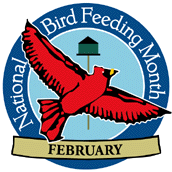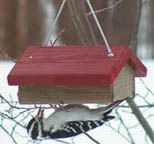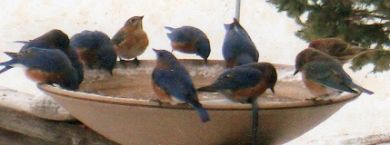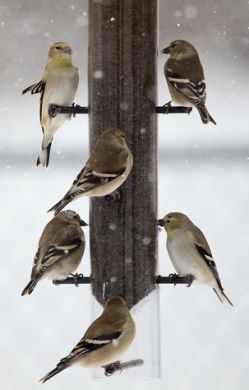Blog - General
Daves February Bird Chatter 2016

February is National Bird Feeding Month. The cold, possible snows and declining natural food resources with most water frozen can have a huge impact on our birds. This month was set aside to encourage people to provide supplemental food sources in backyard bird feeders and an open supply of fresh water.
February is also the month for the Great Backyard Bird Count. If you have not participated in this annual bird count take the time this year .jpg) to do so. You’ll have a great experience plus provide important data to the biologists at the Cornell University Bird Lab. All you need to do is count the birds in your backyard, schoolyard, city park, nature center, anywhere you find birds. It’s fun! It’s free! It’s for the whole family! It’s for the birds! We have all the information you need at the Wild Bird Habitat Stores.
to do so. You’ll have a great experience plus provide important data to the biologists at the Cornell University Bird Lab. All you need to do is count the birds in your backyard, schoolyard, city park, nature center, anywhere you find birds. It’s fun! It’s free! It’s for the whole family! It’s for the birds! We have all the information you need at the Wild Bird Habitat Stores.
Winter is far from over. And as the natural food sources for birds become increasingly scarce or covered by snow, the bird feeders will continue to draw more visitors. Heavy snows to our north have been driving more birds into our area, and new ones can arrive at any time. Keep vigilant about new birds at the feeders. Already this seems to be a banner year for Dark-eyed Juncos and Goldfinches. Some folks have reported Pine Siskins. We have also had numerous reports of Common Redpolls, Red Crossbills, and some Purple Finch You just never know what bird might show up next. So keep a good eye on the feeders.
The Central Great Plains seems to get the heaviest snowfalls in late February and March. It is hard to predict what will happen this year with the ongoing drought. But if a snowstorm does materialize remember not only natural food sources can become covered with snow but so can the grit, small gravel, coarse sand, crushed rock that is essential for birds to digest the seeds they eat. If the ground becomes covered by snow and ice, mix a little grit in your feeders or place some in an open space where it will not become covered with snow. At Wild Bird Habitat you can pick up a bag of “granite grit” specially ground for birds.

Suet will become even more popular now that winter has really set in, and will continue to be so through all of spring and well into the summer months. Woodpeckers consume about 30% more animal protein from late winter through mid-summer than all winter long. The Downy and Hairy Woodpeckers seem to prefer suet, while the Red-bellied Woodpecker will spend more time feeding on peanuts and woodpecker nut mixes. Make suet and peanuts available for these birds. Nuthatches will eagerly feed on these products as will Chickadees and Carolina Wrens.
Many people have reported a large number of Eastern Bluebirds wintering over. Evidently these birds have an adequate food source of berries to sustain them, but may drift off if those food sources dwindle. Some folks have provided them with mealworms or suet nuggets containing insects. These folks have also provided heated bird baths offering a source of fresh water. Others have reported some bluebirds using nest boxes as evening roosts during harsh weather. By months end we may see other bluebirds begin to arrive along with their cousin the American Robin.
weather. By months end we may see other bluebirds begin to arrive along with their cousin the American Robin.
Keep water available for your birds. With an open source of water you can attract more birds than with jus bird feed alone. And as food resources continue to diminish as we move into late winter the backyard bird feeders will become even more popular with birds. Keep them stocked. After all it will be late summer before natural food supplies are replenished.

Some folks have been over-whelmed with Goldfinch while others may have fewer of them. Remember to use fresh Nyjer thistle seed. It will make a big difference. Wild Bird Habitat also stocks a finch mix that we blend ourselves. It is made up of 50% Nyjer thistle seed and 50% ground sunflower chips. This has proven to be a favorite of the finches. But remember that if squirrels are a problem the ground sunflower chips will get their attention in a hurry and you may end up with a damaged thistle feeder. By months end and into early March the numbers of Goldfinches at the feeders will increase dramatically. Our resident adult Goldfinches who drifted south for the winter will be returning. The northern finches that have been visiting us during the winter will remain here until early May before returning to their summer range. Winter is slow to retreat further north.
As I write this newsletter there is a lite snow falling, covering the ground. The birds are busy everywhere feeding to build up energy to get through the upcoming frigid night. It acts as a nice distraction from the keyboard. You know how much enjoyment you get watching the birds at your feeders. The next time you have a guest over, share that excitement with them. National Bird Feeding Month is a great time to get someone interested in feeding birds. Bird feeders make a great birthday gift and are excellent to give on Valentine’s Day to your loved ones. Enjoy nature together. Have a friend over or ask your kids to help you count birds during the Great Backyard Bird Count. Enjoy birding more and remember to feed the birds. It makes a world of difference.
